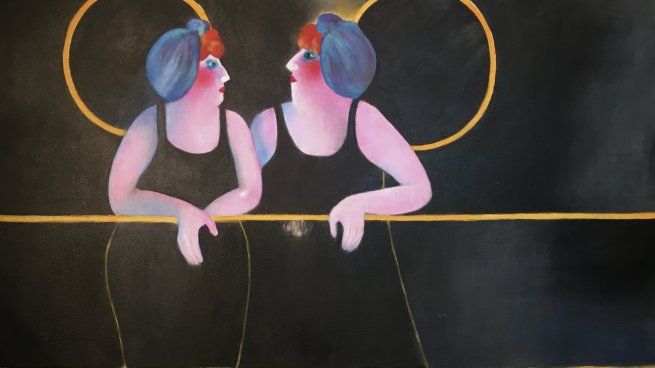The prestigious international Argentine artist inaugurated at La Compañía an exhibition of works made between 1984 and last year, which explore, with an echo pop, a central theme for fantastic literature
Silvina Benguria exhibits a series of paintings made between 1984 and 2023 at La Compañía’s Arenales Street headquarters.. The set of 15 works reaches almost to the present and can be considered a brief anthological exhibition: it allows the viewer to know the identity of the artist. To begin with, the exhibition maintains from the beginning to the end the glamorous colors that characterize the artist. The first thing you notice is the predominance of reds and blues that merge into violet tones, in addition to the very marked traits of humor and reminiscences of Pop art. To the highly sophisticated scenes and playful characters that make up his cheerful and unmistakable style, Benguria adds this time, an immense dinosaur and a strange landscape of Tupungato, with the summit painted in an intense red color.
The content you want to access is exclusive to subscribers.
The exhibition, curated by Fernando Schapire, It opens with the work “Celestial Gloves”. On some black armchairs rests one of the typical women with her plump silhouette, red hair and a light blue dress like gloves.. This character has formed two circles with his index fingers and thumbs and placed them surrounding his eyes. In this way, the woman pretends to look through binoculars. The image has its grace, as do most of the paintings, such as “Dock Sud” and “Turbans”, a series of four red-haired women in red striped dresses.


In a not entirely explicit way, Benguria accentuates expressiveness thanks to the phenomenon of the “double”, that is, the perfect equality of two characters. The “Doppelgänger”, according to the German expression, is frequently found in literature. Cortázar uses duality in the protagonist of “Hopscotch” and is at the same time indebted to authors such as ETA Hoffman, Dostoevsky, Stevenson or Edgar Alan Poe.
Although they are not so frequent in the visual arts, the uses of the construction of the double extend in literature to the present day. Nevertheless, “Turban II,” a large-format painting from 2019, is the best example. The two female characters chat amicably on the deck of a ship leaning on the railing. They are identical and wear identical dresses and turbans, even their profiles with prominent noses and their gesture, their interest in each other, has doubled. Behind, on the black background of the ship, two yellow circles represent the ship’s portholes and reiterate equality.
In the exhibition there is another exact duo of women with red hair and red swimsuits who, this time, face during their swim in the sea and among the waves, the curious and unexpected appearance of a large prawn. Benguria’s doubles replicate the absolute equality of physical features, humor and outfits. Thus the sometimes funny and sometimes ridiculous character of these women becomes much more intense. that, beyond the smiles they awaken, are above all feminine. As feminine as its author.
Boats, a theme that stands out in the exhibition, attract attention due to the elaborate beauty of the chimneys and by the excess of its glorious clouds of smoke, whitish and cottony. Although Benguria’s work is decidedly figurative, the images of the boats are often reduced to an almost abstract approach: a straight line and an oblique line that sinks into the waters. However, the theme that actually runs through the entire exhibition is painting, language and the resources that the artist puts at the service of her lush imagination.
Silvina Benguria began her career in the 60s. In 1978, when he won the Francesco Romero scholarship awarded by the Italian government, he lived in Rome until 1994. When he mentions those years he remembers that he worked a lot, although it was not easy for him. “Rome is such a beautiful and interesting city that it is very difficult to work. You go out to buy something and you stay looking at the churches, the monuments, the fountains… I exhibited there at the Banca di Roma and at the Latin American Institute, I returned because my father had died.” In 1997 he obtained the Pollock scholarship and his career, although it established itself in Argentina, has since then deepened his international profile.
Source: Ambito
I am an author and journalist who has worked in the entertainment industry for over a decade. I currently work as a news editor at a major news website, and my focus is on covering the latest trends in entertainment. I also write occasional pieces for other outlets, and have authored two books about the entertainment industry.




